Calm, quiet, and collected, are you looking for a pet that is all of these? Check out this baby bearded dragon care guide to know more about this peaceful little darling! This guide includes the most basic things you should know about baby bearded dragon care, like what they eat, their ideal enclosures, and more.
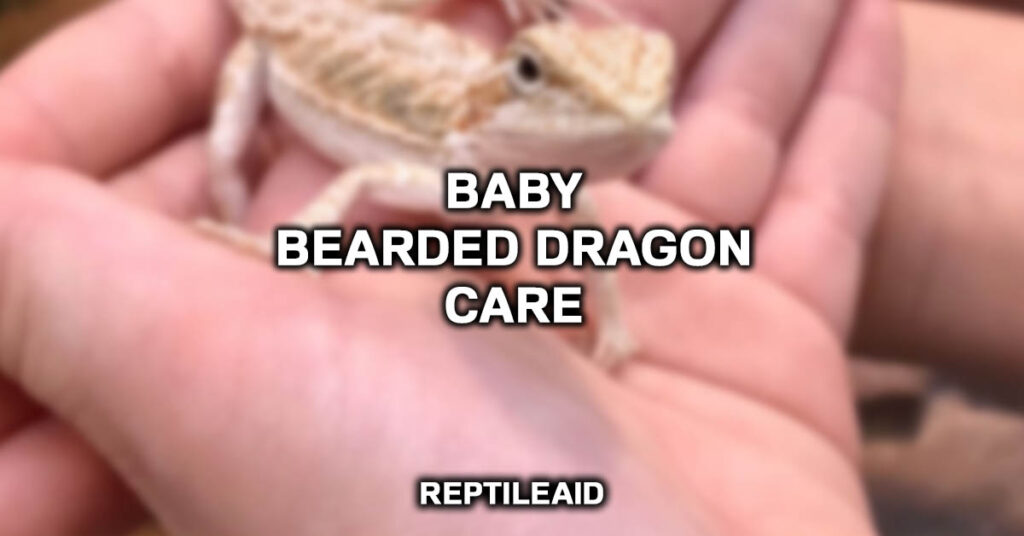
Before getting a baby bearded dragon, it’s important to consider the pros and cons of having one. Here are some points you might want to consider:
Pros
Beginner-friendly
Baby bearded dragons are considered beginner-friendly pets. They get used to their owners pretty fast, making them very trainable! Bearded dragons are generally calm creatures. Just like humans, bearded dragons as babies, are always full of energy.
They like to run and jump around, especially when handled by new owners. But as they mature, they lose most of the baby’s energy and become more still.
Solitary
No pair, no care! Even as babies, bearded dragons can pretty much survive without having another dragon friend with them in the enclosure. They’re solitary reptiles, and they’re very territorial, especially when they mature.
Quiet
If you live in an apartment, or in a residence where people are strict about noise, then a baby bearded dragon might be a great pet for you! Considering their calm nature, it’s no surprise that baby bearded dragons are quiet creatures. Although, when they get upset, they’ll hiss and puff up their “beard”! Other than the hissing, they’re mostly unbothered!
Good size and weight
Bearded dragons can be bought, or adopted as babies or adults. A good thing about getting them as a baby is the chance to watch them grow! Baby bearded dragons can grow up to 24 inches when they fully mature! 24 inches is a good handling size, as it’s not too big nor too small! Also, their maximum normal weight is 380 grams to 510 grams. Be careful to not make them too chubby though!
Long lifespan
Good news! Your baby beardie will be with you for a long time. With proper care, bearded dragons can live for up to 15 years!
Cons
Costly
Though getting bearded dragons as babies will allow you to have them for a longer time, it can be quite expensive! Baby bearded dragons consume much more protein, compared to adult bearded dragons. Their diet is mainly composed of protein and greens. Generally, food rich in protein can cost more than leafy greens.
Temperature-sensitive
A baby bearded dragon’s health will heavily rely on temperature. Controlling the enclosure’s temperature can be quite tricky, especially if it’s a small cage. Installing lights and other fixtures that will help control temperature is another cost to consider.
Risk of Salmonella
Just like many animals, bearded dragons can carry a bacteria called Salmonella. Salmonella is found in their droppings, and can easily spread in their enclosure. It’s important to maintain cleanliness in the bearded dragon’s cage to keep it from getting sick.
Expert Tip: Don’t forget to thoroughly wash your hands after cleaning or handling as humans can get sick with Salmonella as well!
Now that you’ve learned the pros and cons of owning a baby bearded dragon, here are important things you must know to properly care for your baby beardie:
Picking a healthy baby bearded dragon
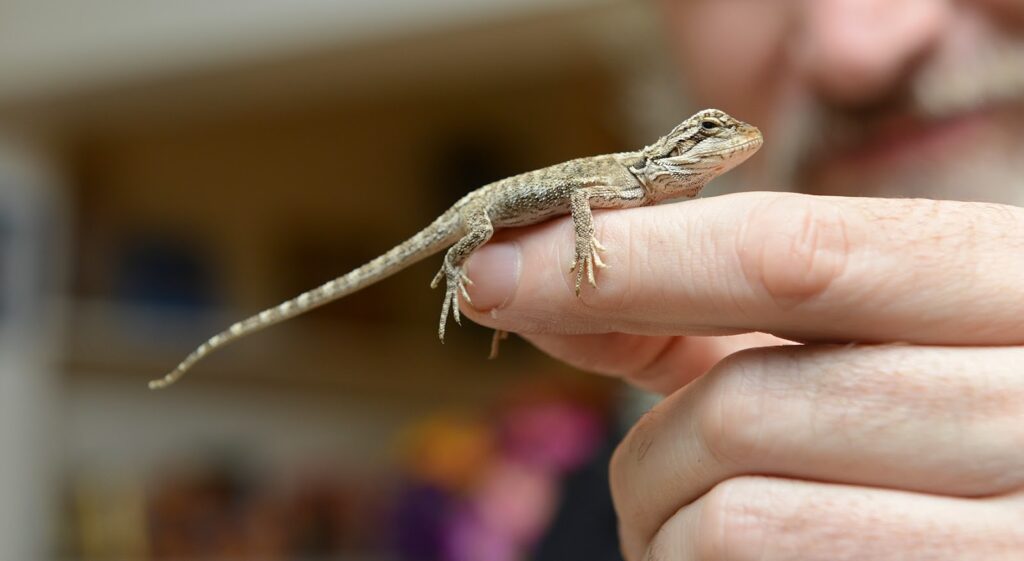
It’s important that the baby bearded dragon you’re about to adopt is healthy! Where you get your pet from can help you know if they’re healthy or not. A healthy baby bearded dragon ensures that you’re safe from any illnesses it might carry. Also, a healthy beardie will spare you from expensive vet visits.
Breeders
While there are many options, the safest choice is adopting or buying through a breeder. Breeders know how to properly care for a specific animal, and they usually aim to produce high-quality, and healthy offspring. Acquiring baby bearded dragons through breeders will also give you the option to choose a specific color.
Reptile expos
Looking for a baby bearded dragon breeder can be challenging, especially if you’re a new reptile parent! Reptile expos are events where different reptile breeders and enthusiasts gather to display and sell their specialty reptiles. If there are reptile expos in your area, you can go check for baby bearded dragons!
Pet shops
Yes, baby bearded dragons in pet shops! Nowadays, more and more pet shops sell exotic pets, like bearded dragons. Though pet shops might be the most convenient place to buy baby bearded dragons, they probably have ones that are not very healthy. Bulk-buying of animals is common for most pet shops.
This process can be very stressful for animals, especially if they are shipped from overseas.
Reptile rescues
Rescue animals are usually not in their best shape, but giving them a new home would be such a sweet gesture! Baby bearded dragons might be rare in reptile rescues, though, because animals are usually given up when they become adults.
Housing
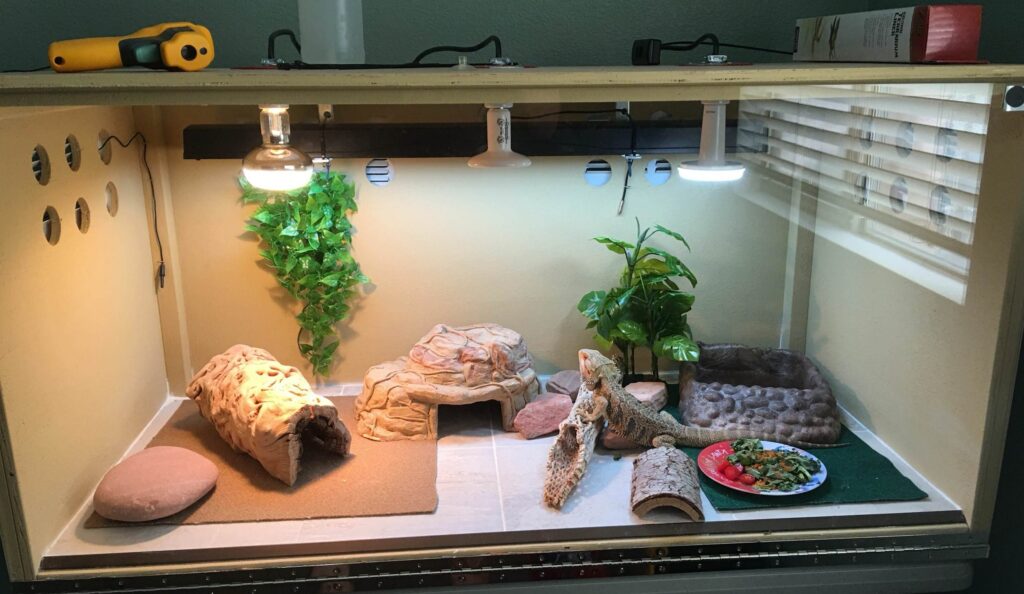
Before getting into detail, here’s a list of the things you should get for your baby bearded dragon’s home:
- Enclosure
- Substrate
- Lights
- Thermostat
- Thermometer
- Food container
- Water container
- Ledge for a basking spot
- Pieces of wood
- Interactive pieces
- Hiding places
Enclosure
It’s important to know that the bigger the bearded dragon gets, the more space it needs. A 20-gallon tank is enough for a small, baby bearded dragon that’s about 10 inches. But, since they’ll grow eventually, a bigger tank would probably be a wiser choice. For reference, the minimum tank size for a fully-grown adult bearded dragon is 40 gallons.
Expert Tip: Another thing to consider when choosing your baby bearded dragon’s tank is the material. Most pet tanks are made of glass or plastic. For bearded dragons, a plastic tank is preferable. This is because glass tanks tend to create reflections.
And because bearded dragons are territorial by nature, they might feel stressed when they see “another” beardie in their reflection.
Substrate
First of all, what is the substrate? The substrate serves as the tank’s flooring or bedding. A sand mat or any textured mat is an excellent choice for a substrate, because it does not have actual sand, but it provides a rough flooring that’s good for your baby bearded dragon’s nails!
A mat provides consistent flooring because it won’t easily budge when your baby bearded dragon runs around in the enclosure. Other good substrates are paper towels and newspaper. They’re affordable and easy to replace. Also, since most paper towels are light-colored, your baby bearded dragon won’t have a hard time spotting any live food!
Calcium sand may sound like a good idea for a substrate, but it actually has many disadvantages. Impaction (obstruction of food or debris in the body) is a common problem when having calcium sand as a substrate. When live food is placed in the tank, they will tend to dig or wiggle around, making themselves covered, or buried in the sand.
So when your baby bearded dragon tries to eat them, it might ingest the sand as well. Using calcium sand alone will also make an inconsistent flooring that might expose the tank’s bottom, making it difficult for your baby bearded dragon to walk, or run around.
Lights and heat sources
Two types of lights are needed in a baby bearded dragon enclosure. A UVA/UVB bulb, and a heating, spot bulb. The UVA/UVB bulb should cover about 2/3 of the entire tank. The UVA will keep your baby bearded dragon happy and active, and the UVB will help promote bone growth and provide vitamin D.
This bulb will also make up the “cool” side of the enclosure. Next, the spot lamp. The spot lamp is very important because reptiles need to bask under a heat source so they can absorb nutrients from their food! The spot bulb should be placed right above the basking spot, so your baby bearded dragon can receive enough heat.
A hot rock is not recommended because it can easily overheat. Also, baby bearded dragons need a heat source on top of them, like the sun. Because their undercarriage is quite sensitive, a hot rock won’t really provide any benefit.
Thermostat
Since the enclosure is heated, it’s important to control the temperature by using a thermostat. A thermostat with an alarm and timer is good for easier monitoring.
Thermometer
Aside from a thermostat, a thermometer will also help you in monitoring the tank’s temperature. The entire enclosure will typically have three temperatures. The cool side should be 21-27 degrees Celsius, the warm side 29-35 degrees Celsius, and the basking spot 38-39 degrees Celsius.
Food and water containers
The food container and water container should be shallow. A shallow food container will prevent any live food from sinking to the bottom. The maximum water level should only be about half of your baby bearded dragon’s height. Too much water is not recommended because your pet might drown.
It’s also unnecessary because the water can get soiled easily, so you’ll still have to change the water daily. The shallow water container also doubles as a soaking dish that will help them shed!
Basking spot
A ledge or a rock where your baby beardie can comfortably bask should be placed right below the heating spot lamp.
Wood, interactive pieces, and hiding spots
These are some things your baby bearded dragon will need so they won’t feel bored. You can actually try putting different things in the tank, and see which ones are your baby’s favorites! Wood can be a very good interactive piece because your baby bearded dragon can climb on it. It can even serve as a great hiding place if it’s a small, hollow branch.
Aside from climbing and hiding, baby bearded dragons would enjoy smelling different things. Try to put different fruits or mild-smelling things in the tank for a little while, and see if your baby beardie likes it!
Diet
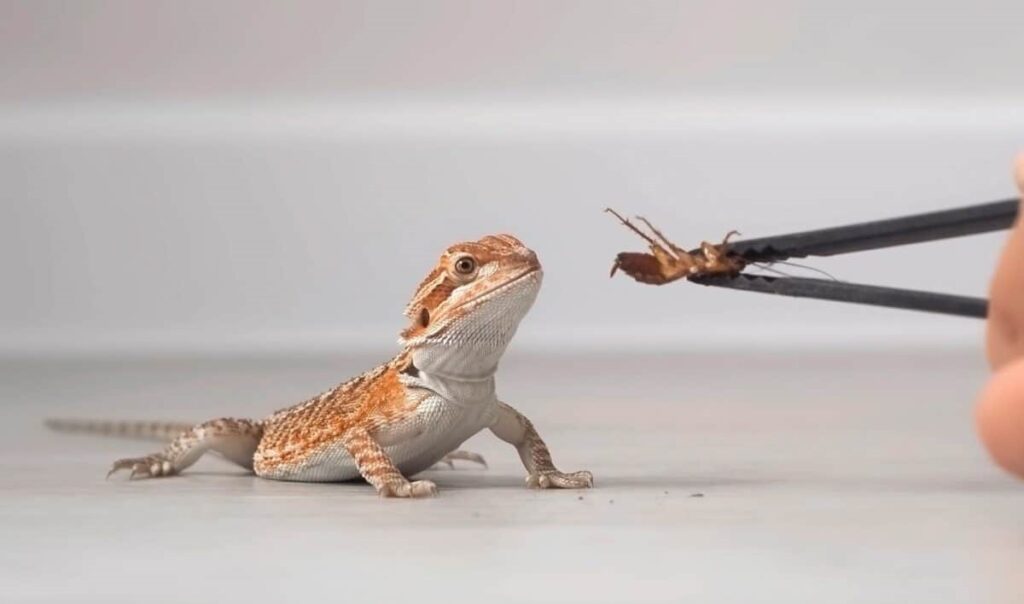
Eyes here, beardie parent! Knowing what kind of food your baby bearded dragon needs is super important for its growth. Generally, the biggest difference between an adult bearded dragon and a baby bearded dragon is their diet. Their diet mainly consists of protein and leafy greens. As babies, bearded dragons require a larger protein intake.
Their food should be 80% protein, and 20% leafy greens. This will change after two years when they fully mature into adults. An adult bearded dragon’s diet should consist of 60% leafy greens, and 40% protein.
So, what exactly should you feed your baby bearded dragon? Small baby crickets are very good protein sources, and they even make your little beardie run around to catch them. That’s good exercise if you ask me! Baby bearded dragons are voracious eaters. They’ll need to eat 2-3 times a day.
In a day, they can consume up to 60 baby crickets! Baby bearded dragons are just like little kids, they won’t finish their vegetables! Even if you put a bunch of leafy greens in their food container, they will most likely just leave them there. You can trick them into eating their vegetables by rolling or cutting leaves into strips.
This will make the leaf look like a worm, especially if you wiggle it around in front of your baby beardie’s face! Good luck!
There is some food that you should never feed your baby bearded dragon. Here’s a list:
- Iceberg lettuce (calcium binder)
- Avocado (calcium binder)
- Broccoli (calcium binder)
- Cauliflower (calcium binder)
- Mealworms (rich in chitin. hard to digest)
- Super worms (rich in chitin. hard to digest)
- Wild horn worms (might be poisonous)
- Wild crickets (might have parasites)
Maintenance
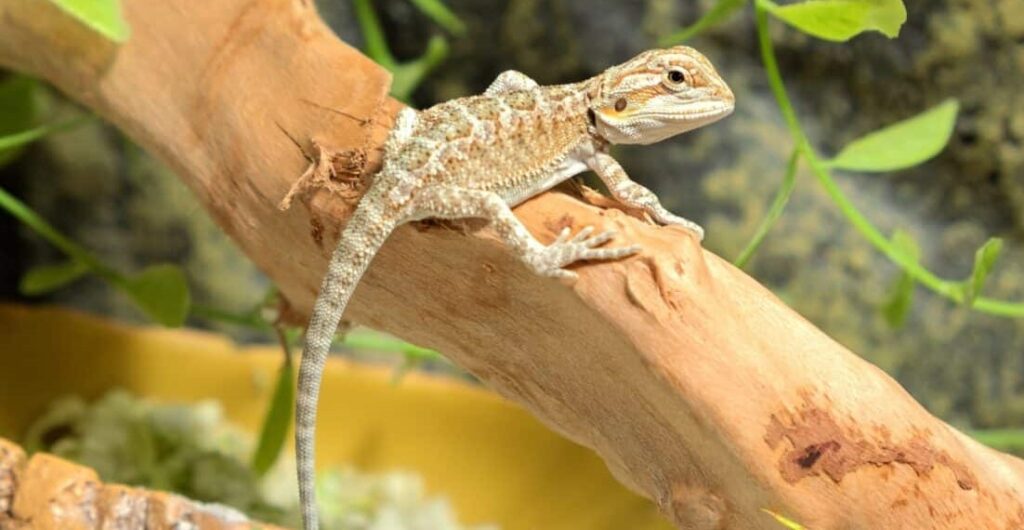
Baby bearded dragons are not really hard to maintain. As they grow older, they become even more independent so you won’t have a hard time taking care of them. Here are the things you should take note of to maintain your baby bearded dragon:
Shedding
Like all reptiles, baby bearded dragons shed. A soaking dish, or their water container, will help them soften their skin for easy shedding. Some baby beardies will refuse to soak through. Placing them in a small tub or pool for a few minutes daily will ensure that their skin does not get too dry.
If they still aren’t used to soaking, you can try misting them once a day. Gotta stay hydrated!
Nails
It’s important that their nails don’t grow too long to avoid hurting themselves. Though the rough sand mat and wood pieces will keep their nailed filed down, it’s still good to check or trim them every once in a while. If you accidentally cut too deep and they bleed, cornstarch can help control the bleeding.
Cleanliness
Regular cleaning of the enclosure can reduce the growth of unwanted bacteria, like Salmonella. Cleaning and emptying food and water containers should be done daily because your baby beardie can be a big pooper!
Common illnesses
Before you get your baby bearded dragon, make sure that there are vets in your area who treat bearded dragons. Also, you should understand that if you can’t afford a vet. you probably also cannot afford the pet. The most common illness among bearded dragons is MBD (metabolic bone disease). This disease is caused by the lack of exposure to UVB.
If your baby beardie doesn’t get enough UVB, it can’t properly absorb calcium from its food. This is why it’s very important to have a light in the enclosure that gives off UVB. Also, as babies, bearded dragons need to bask 80-90% of the day.
To make sure they bask enough, during the day you can remove caves or places where they can hide, and put the fixtures back at night time!
Here’s a fun fact: bearded dragons don’t urinate liquid! Their “urine’ is solid, and it usually comes with their droppings. So, if you see a white substance along with their poop, that’s a good sign because it’s actually their pee.
Groups and resources
You can never do too much research! There are so many websites and groups made specifically for baby bearded dragons. Feel free to visit some websites, watch videos, and even join Facebook groups about baby bearded dragon care, breeders, and more. We’d want the best for our baby beardies, right?
Ready for your new baby? Here are some fun facts about bearded dragons that will make you want them even more:
- Just like humans, they wave to say hi to their friends!
- They can grow their teeth back if they lose them.
- Sometimes they will have two heads
- During incubation, when the temperature is high, bearded dragon eggs will develop as females. And when the temperature is low, they will develop as males. Awesome, right?!
Baby Bearded Dragons
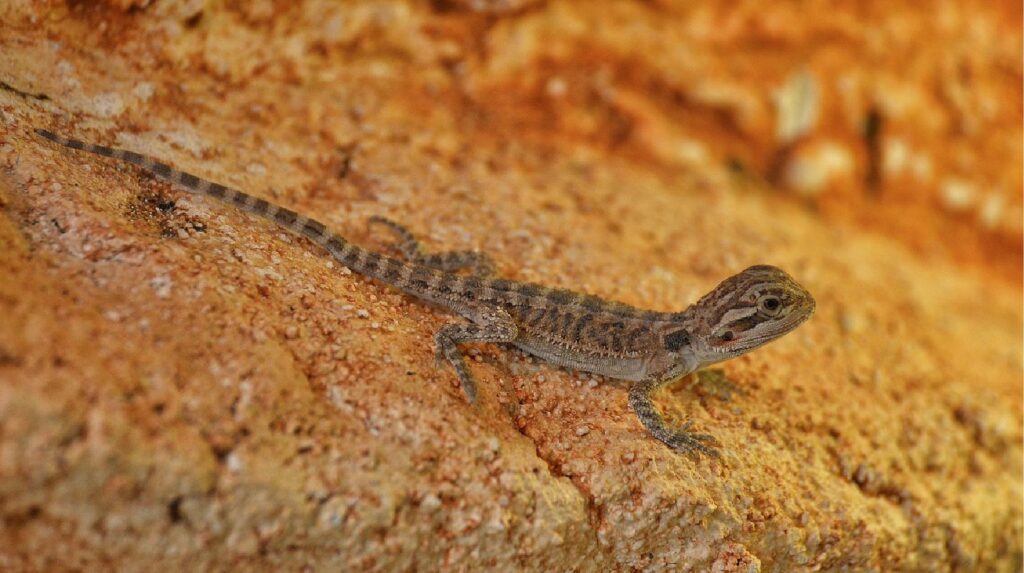
Bearded dragons have become an increasingly popular pet among reptile lovers. They are known to be friendly, and sweet lizards. These dinosaur-looking reptiles make great pets as they are easy to care for, and can easily adapt. The same can be said about their hatchlings.
Bearded dragons can be considered babies when they are about four to five months of age. At this stage, they need nutrients and vitamins to facilitate their rapid growth. Bearded dragons are omnivorous.
Hence, their little ones will also feed on small insects such as crickets and chopped vegetables. The food that enters their mouth should be in small portions so as to avoid any chewing or digestion issues. The ratio should be 80% insects and 20% greens. It is recommended to feed them 3 to 4 times a day.
Expert Tip: It is also important not to dehydrate them as this is the most common issue among beginners. Their water bowls must be changed every day. Choosing a shallow bowl will keep them from drowning. To ensure that they are hydrated enough, misting can be done.
In general, looking after a baby bearded dragon is quite simple. Just like any other pet, they need a responsible owner who can meet their basic demand for them to be healthy and to thrive.
How Often Should I Handle My Baby Bearded Dragon?
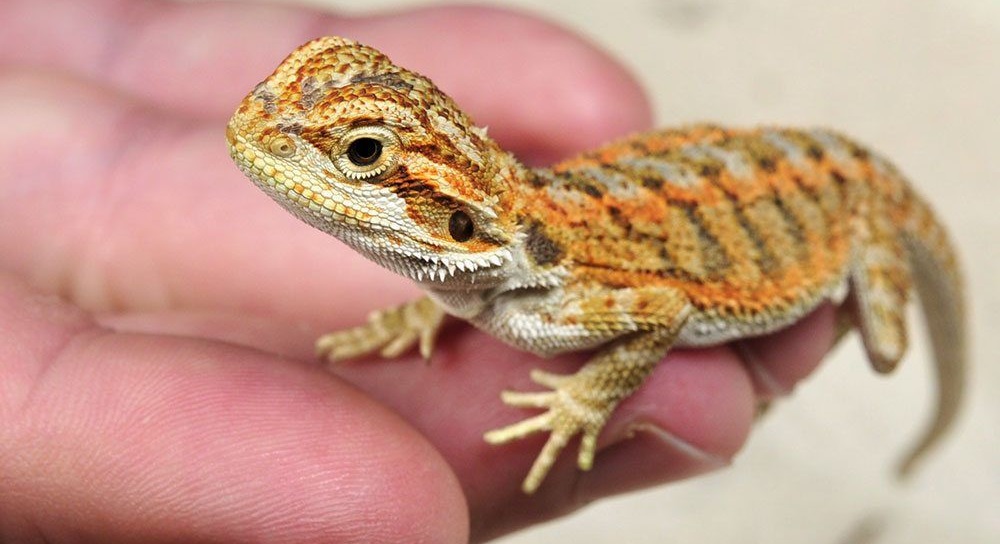
Bearded Dragons are usually more tolerant than other lizards when it comes to handling. On the other hand, baby Bearded Dragons will need to get used to their habitat and surroundings before you start handling them for extended periods. If you just got it, let it explore its tank or cage for the rest of the day. You may start getting to know each other on the following day.
Try handling it for 10-15 minutes initially, about twice or thrice a day, for the first week. Bearded dragons like company and they will bond easily once you get to know each other. Handle it carefully if this is your first time with this kind of pet. Try to get used to the feel of its feet on you and let it get to know you as well.
If you go to work, don’t worry about leaving your beardie for long stretches of time. Just make sure to spend time with it once you are at home.
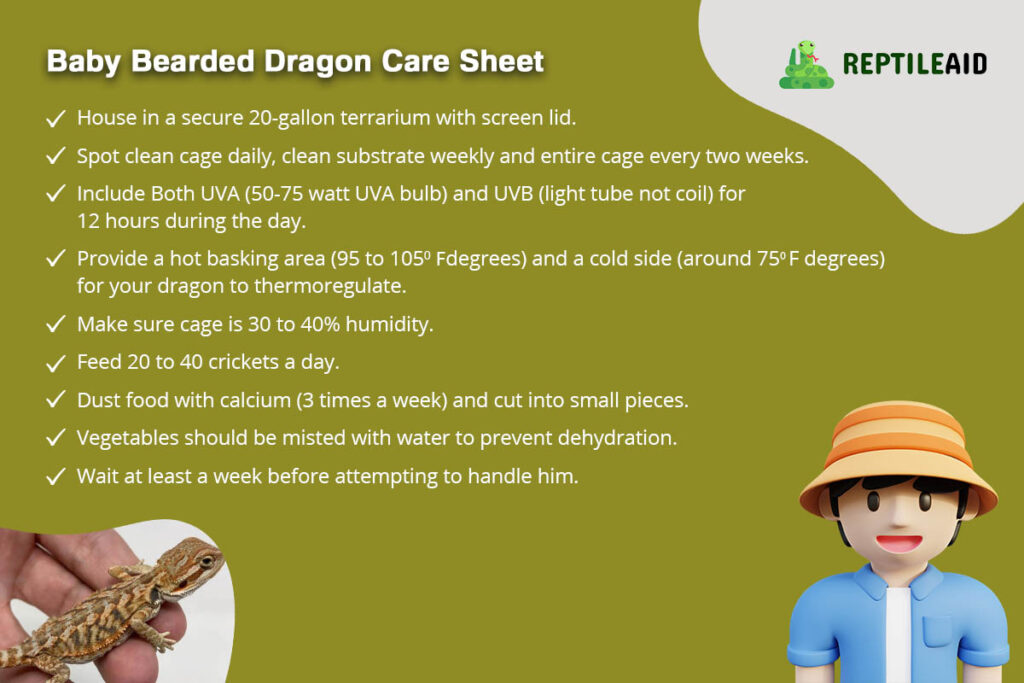
Conclusion
If you’ve read up to this point, good news! I think you’re ready to take care of your very own baby bearded dragon. Just remember, proper lighting, a big tank, proteins and greens, and daily cleaning! I’m sure your baby would be very happy to have you as their owner!
If you have some questions, you can always come back to this care guide. Best of luck, beardie parent!
